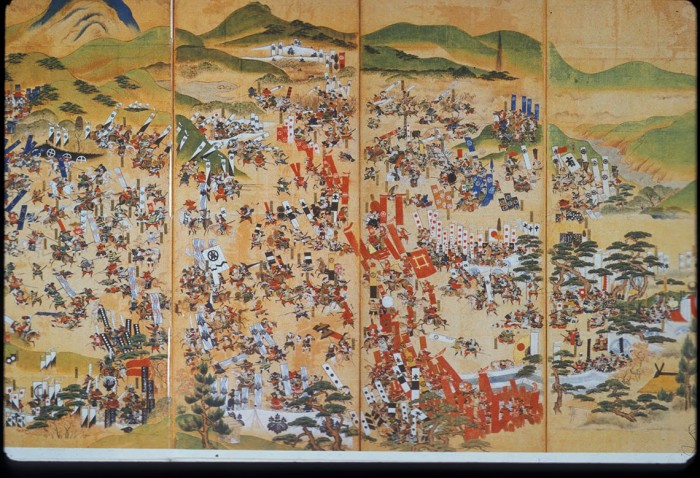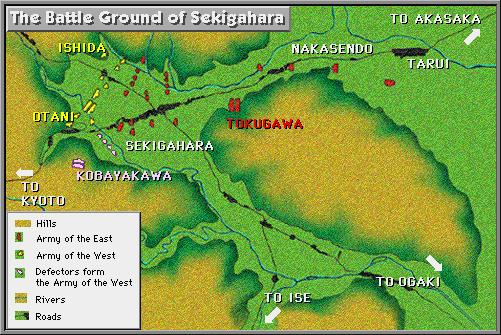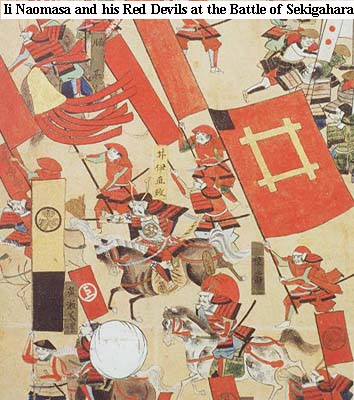
On the fateful night of October 20, 1600, Ishida Mitsunari – commander of the ‘Army of the West’, made the decision to withdraw his forces from Ogaki castle to defend the narrow pass at Sekigahara against the advancing ‘Army of the East’. The twelve mile march took the bulk of his army directly west to the Ise road, then north along that to the village of Sekigahara. Other units stationed at Tarui marched directly back along the Nakasendo to meet up with Ishida at Sekigahara. Unfortunately for Ishida’s troops the night march took place at the height of a storm, with the rain lashing directly in their faces. The 80,000 strong army arrived to take up their positions at Sekigahara absolutely drenched.
Tokugawa Ieyasu – commanding the ‘Army of the East’ – was that night stationed at Akasaka, also on the Nakasendo, and directly north from Ogaki. As soon as he heard of Ishida’s move he too mobilized his troops and set them off on the march to Sekigahara. Luckily for his men the worst of the storm had blown over by then, but conditions were still bad enough that when his advance guard passed through Tarui they inadvertently walked into the rearguard of the Western forces, marching in the same direction.

The village of Sekigahara lay straddled along the Nakasendo, but at the junction with the Ise road running south, and the Hokkoku road running to the north-west. Ishida positioned his troops to the west of the village, therefore, where he could cover any movement along all three roads. Setting his own camp on the northern flank of the valley, just above the Hokkoku road, his battle line extended south-east across the valley floor to cross the Nakasendo at Fuwa, the site of the old 7th century barrier station. It was here, on a mound overlooking Fuwa from the north, that he placed one of his most trusted and battle hardened divisions, under the command of Otani. It was also here, within the next few hours, that the fighting would be at its fiercest and where the most crucial stages of the battle would be fought.
Among his commanders Ishida knew already that there were some whose loyalty to his cause was in doubt. He could not express his doubts openly for fear of offending them and thus turning them definitely against him. Instead he gave Kobayakawa (whose loyalty was in most doubt) the prestigious position of commanding the right wing of his battle line. This seemed to have a good deal of sense, because it placed Kobayakawa on the hill slope overlooking the Nakasendo from the south, in a position where the troops were unlikely to have an influence on the most serious fighting. In this respect Ishida seems to have anticipated the battle would be hardest fought in the center of the valley, along the Hokkoku road. Unfortunately for Ishida this turned out to be a severe misjudgement.

Tokugawa himself hung back to the east of the village with his own troops held in reserve. He encamped on a small promontory next to the Nakasendo, from where he could observe the progress of the fight. The first shots were fired at 8 o’clock, as the mist lifted barely sufficiently for the front ranks of the two sides to see each other for the first time. Impetuously, Ii Naomasa led his troops in a furious charge across the Hokkoku road, just as Ishida had hoped. It is likely that Tokugawa saw nothing of this, for the mist had still not cleared. By the time he could see what was going on, a few minutes later, the pattern of the battle had already been set. His troops were on the advance, all along the line, and Ishida’s numerically superior troops were putting up fierce resistance.

Other pages of related interest:

